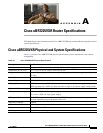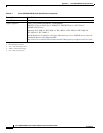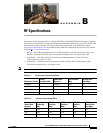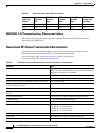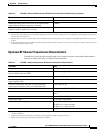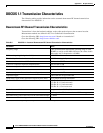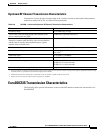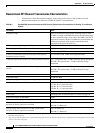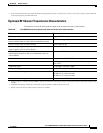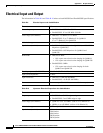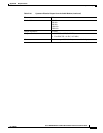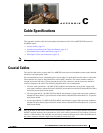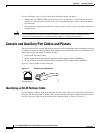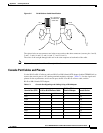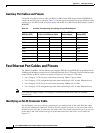
B-7
Cisco uBR7225VXR Universal Broadband Router Hardware Installation Guide
OL-17309-02
Appendix B RF Specifications
EuroDOCSIS Transmission Characteristics
Upstream RF Channel Transmission Characteristics
Transmission is from the cable modem output at the customer location to the headend.
3. For hum measurements above the normal downstream operating frequency band, a continuous-wave carrier is sent to the test frequency at the same level
as the highest-frequency PAL/SECAM carrier.
Table B-8 EuroDOCSIS Assumed Upstream RF Channel Transmission Characteristics
Parameter Value
Frequency range 5 up to 65 MHz to edge
Transit delay from the most distant cable modem to the
nearest cable modem or cable modem termination system
≤ 0.800 msec (typically much less)
Carrier-to-noise ratio in active channel Not less than 22 dB
Carrier-to-ingress power (the sum of discrete and broadband
ingress signals) ratio in active channel
Not less than 22 dB
1
1. Ingress avoidance or tolerance techniques may be used to ensure operation in the presence of time varying discrete ingress signals that could be as high
as 0 dBc.
Carrier-to-interference (the sum of noise, distortion,
common-path distortion, and cross-modulation) ratio in
active channel
Not less than 22 dB
Carrier hum modulation Not greater than –23 dBc (7%)
Burst noise Not longer than 10 microseconds at a 1 kHz average rate for
most cases
2,
3
2. Amplitude and frequency characteristics sufficiently strong to partially or wholly mask the data carrier.
3. Impulse noise levels more prevalent at lower frequencies (<15 MHz).
Amplitude ripple 5 to 65 MHz: 2.5 dB in 2 MHz
Group delay ripple 5 to 65 MHz: 300 ns in 2 MHz
Micro-reflections—single echo –10 dBc @ ≤ 0.5 microseconds
–20 dBc @ ≤ 1.0 microseconds
–30 dBc @ > 1.0 microseconds
Seasonal and diurnal signal level variation Not greater than 12 dB min to max



